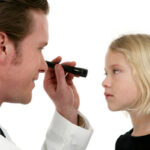For most of us, trying to put eye drops in our own eyes can be a frustrating challenge, so when it comes to trying to accomplish the task with our children, it can be double frustrating, messy, and seem downright impossible. Here are some tips for parents to make the administration of eye drops a little less daunting.
Eye drops may be prescribed for a variety of conditions and illnesses, the most common if which is conjunctivitis or pink eye. This highly contagious condition is very common in children and can be passed around easily and often in day care settings, schools, neighborhoods and families. It is spread through direct contact and by coming in contact with bodily fluids (from coughing and sneezing) of an infected person.
In infants and small babies, it is helpful to swaddle or wrap the baby tightly in a blanket if there is only one adult to administer the drops. This way, the adult can concentrate on gently holding open the bottom lid and dropping in the medication. If there are two adults, one can hold the infant or baby (it still might help to swaddle) while the other holds open the bottom lid. Either dropping the liquid into the corner of the eye and letting it roll into the eye, or dropping it into the pocket created by gently pulling out the lower lid can be good ways to get the most fluid actually into the eye.
Older children, may create more of a challenge since they are more mobile! Start by finding a position that makes the child feel the most relaxed and in control. This can be standing, sitting or lying down. For my own children, lying down with their head in my lap seemed to work best. They felt nurtured and protected and I knew it was harder for them to run away. For older children, it may work better to gently open the child’s eye (gently, but forcibly since the child will automatically want to squint and squeeze the eye tight) using the thumb and forefinger of one hand. It doesn’t do any good to tell your child to “Keep the eye open!” it just goes against all human nature and natural behavior for a child to keep his or her eye wide while something is put into it.
As with an infant, drop the liquid into the inside corner of the eye and let it roll into the eye, or if you can open the bottom lid to create a little pocket, drop the medication into the pocket. Be sure to have a soft towel or cotton swabs handy to wipe up any extra that may escape. The liquid drops can feel icky and cold on the faces of some kids and might get into the ears (if laying down) or mouth and create an unpleasant sensation that only makes things worse.
Depending on the personality of your child, some will want to get things over quickly, while others may need to get calm between eyes. Encourage the child to close his or her eyes for a few seconds after the drops have been administered. Some parents prefer the “surprise method” of trying to get their child calm and then surprising them with squirt of drops. I’m of the opinion this only creates distrust and will make it more challenging the next time the drops need to be administered. It is helpful if you can build an expected routine way of handling eye drops so your child will experience less fear and the task can be accomplished with less stress, tears and tension!



